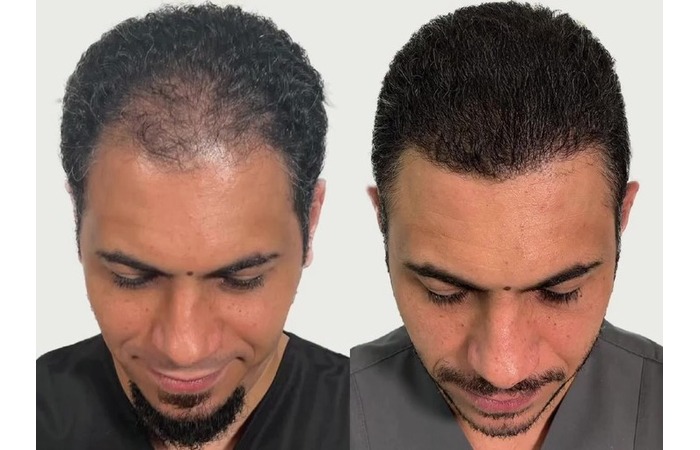If you’re thinking about getting a hair transplant in Turkey, one of the first questions you’ll have is: How many hair grafts will I require? Whether you're looking to fill in your temples, cover a thinning crown, or lower your hairline, knowing the number of hair grafts required is key to planning your hair restoration treatment — and determining the cost.
Hair transplant surgeons typically assess factors like the size of the thinning or bald area, your current hair density, and your donor hair quality to determine how many grafts are needed. But if you want a more immediate way to determine the number of hair grafts needed, you can try a helpful tool that can give you a head start: the hair graft calculator.
This tool helps to give you an estimate based on the extent of your hair loss and your desired results. While it’s not a substitute for a professional hair loss assessment, it’s a useful first step in mapping out your hair restoration plan and hair transplant budget.
If you're curious about what your hair transplant might involve, trying a hair graft calculator is a one way to get started with a plan — and when you're ready for expert hair regrowth advice, the Este Medical team in Turkey is here to guide you on your journey to replenished hair and a renewed self-confidence!
What is a Hair Graft?
A hair graft (also referred to as a follicular unit or hair plug) is a small piece of skin containing hair follicles (typically 1 to 4) that is harvested from one area of the scalp and transplanted to a balding or thinning area during a surgical hair transplant procedure. These grafts are the building blocks of a hair transplant. During a DHI or FUE procedure, strategically relocating these hair grafts one by one helps restore hair to the desired area of the scalp.
How Many Hairs are Typically in a Hair Graft?
A graft typically contains a few hair follicles along with a small amount of surrounding skin tissue that serves as a base or anchor. During a surgical hair grafting procedure, these grafts are moved from one area of the scalp to another. Hair grafts are the unit of transfer in the restoration process, helping to rebuild natural-looking hair density in thinning or balding areas.
Where Can I Find a Hair Graft Calculator?
You can find hair graft calculators online, often on hair transplant clinic websites. These calculators are designed to estimate the number of grafts needed for a hair transplant based on factors such as the extent and pattern of hair loss, your desired hair density, and the type of hair restoration technique. Some hair graft counting tools also incorporate the Norwood scale and may provide approximate hair graft cost estimates.
If you’re concerned that a clinic’s calculator might be biased, you can explore independent hair graft calculator apps on the App Store or Google Play.
What Kind of Questions Does a Hair Graft Calculator Ask?
A hair graft calculator typically asks a series of hair-related questions to help estimate how many grafts you may need for your hair transplant. Here are common types of questions to expect:
- What is your current level of hair loss?
This may be shown using a visual scale like the Norwood Scale (for men) or Ludwig Scale (for women) to help assess the pattern and severity of hair loss. - Which areas do you want to restore?
You'll often be asked to select areas like the temples, crown (bald spot), or front hairline that you want filled in with hair grafts. - What is your desired hair density?
Some calculators let you choose between light, medium, or high density based on your preference for hair thickness. - What is your hair type or hair texture?
This includes fine, medium, or coarse hair, as different textures impact how well the scalp appears covered. - What is your age and ethnicity?
Age helps determine long-term hair loss expectations, and ethnicity can influence hair characteristics like curl pattern, strand thickness, and follicle shape, which all impact hair graft requirements to reach your hair grooming goals. - Have you had a hair transplant before?
Prior hair transplant procedures can affect available donor hair and influence hair graft planning. - What is your general health?
Medical history can help determine if you're a good candidate for certain hair restoration techniques.
What is the Ludwig Scale?
The Ludwig Scale is a medical classification system used to measure the progression of female pattern baldness. It helps hair restoration specialists assess the severity of hair thinning, especially at the crown and along the part line. This scale ranges from mild to advanced hair loss and is commonly used when planning female hair grafting treatments. By identifying where a woman falls on the Ludwig Scale, a hair transplant clinic like Este Turkey can better estimate how many hair grafts are needed to restore natural density and fullness.
What is the Norwood Scale?
The Norwood Scale is a widely used tool for categorizing the stages of male pattern baldness. It helps hair transplant professionals evaluate how much hair has been lost and where restoration is needed, such as receding temples, thinning crown, or a full top bald spot. This classification ranges from early signs of recession to more advanced baldness. Understanding where a person falls on the Norwood Scale allows specialists to calculate the number of hair grafts required and create a customized treatment plan. While the Norwood Scale is for men, women are typically assessed using the Ludwig Scale.
Why Does a Professional Hair Loss Consultation Still Matter?
While online hair graft calculators and hair loss classification scales like the Norwood and Ludwig provide helpful estimates, they can’t replace the value of a personalized consultation. The most accurate way to determine how many hair grafts you truly need — and which transplant method is best suited to your goals — is through a personal consultation with a reputable hair loss clinic. A professional hair loss assessment takes into account your hair type, age, hair loss pattern, and long-term expectations. At Este Medical in Turkey, our hair transplant experts are committed to designing a bespoke hair restoration plan that delivers natural-looking, lasting results tailored to you.
Contact Este Medical Group and be guided by our hair loss pros in Turkey for the best number of hair grafts to reach your goals!









.jpg)














